Google Ads History And The Rise of The Internet
Before we look at the Google Ads History, we need context. The first computers built in the 1950s had little functionality. The exchange of data was problematic and slow.

The Internet arrives
The need for computers to be connected goes back to the 1960s when the US Department of Defence initiated work on the Advanced Research Projects Agency Network. It would become the foundation of the internet.
Initial progress was quite limited as applications were very specialised and significant network compatibility issues had to be overcome. Commercial internet service providers began in the late 1980s.
Netscape and Microsoft were the first major players in the browser wars in the mid to late 1990s. Google started in a garage in California in 1998.
Classified Advertising and Yellow Pages Dominated Local Advertising
For many decades, small home service businesses relied on printed ads to find new customers. Classified listings in newspapers and in the Yellow Pages were the preferred options. Listings in the Yellow Pages were an annual event. The information that was permitted in an ad was limited to a few lines of cluttered service/product descriptions. Consumers were not that well informed about the complexity of the individual companies.
In the Home Services section, Yellow Pages was seen almost like a monopoly. Yellow Pages became more and more expensive, yet the service remained the same. As advertising returns on investment started declining, advertisers were desperately looking for alternatives.
Google Adwords Debut
Google AdWords was launched on 23 October 2000 with 350 advertisers. It was a fairly basic service and searches were not very accurate. In those early days, there were about 20 million searches per day on the Google search engine.
Fast forward to 2018 and daily searches are estimated to be 3 500 million each day. The number of advertisers on Google has also grown significantly over the last decade. For most Home Service providers, Google Search is today the most sophisticated and effective advertising instrument available. Read more on the effectiveness of Search.
Income from Google Ads and associated services form the bulk of their revenue generated. This points to how the Google advertising platform took the world by storm. The steady rise of Google revenue is clearly shown in the chart below.

What factors contributed to Google’s success?
The popularity of the internet – As online browsing returned more accurate search results, so our reliance on getting information from the internet increased. Google has transformed their advertising service into a complex multi-feature behemoth.
Google Ads is changing often with many new features – The advertising platform has changed more in the last two years than at any time in its history. Google advertising training, advice and support is a constant high-quality service. Google’s objective is to make Google searches more accurate.
Mobile phones are really minicomputers – Mobile and tablet searches now account for more than 70% of overall browsing traffic. With technology improvements and generational search changes, the dominance of mobile searches will only increase. The changes in consumer behaviour – wanting information on the move – supercharges Google search engine browsing volumes.
Lack of search engine competition – In Australia, around 90% of searches are done through Google. Advertisers will always trend to the search engines that provide quality search experiences and provide a solid return on investment. Google Ads ticks these boxes. As managers of Google Ad campaigns, we would love to see a serious competitor come through.
Looking ahead with Google Ads
Because Google documents our browsing history, this information can be used to segment advertising services in a much more sophisticated and accurate manner. Minor segmentation has been introduced, but it is really the tip of the iceberg.
During the last few years, Google Ads have attracted more advertisers and become much more expensive. The Google Ads return on investment is declining and advertisers are desperately looking for alternatives. Organic Google, Facebook, Instagram, Bing, offer some options but do not constitute a major threat to Google Ads at the moment.
The lesson with the rise and fall of Yellow Pages and early browsing giants can repeat itself. So far, the Google Ads History story has remained ahead of the competition by constantly looking at ways to provide a more accurate and diverse online advertising service.
Online References:
https://www.wordstream.com/articles/interactive-history-of-adwords
https://en.wikipedia.org/wiki/AdWords
https://instapage.com/blog/google-adwords-infographic
